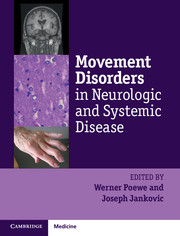Book contents
- Frontmatter
- Contents
- List of contributors
- List of videos
- List of abbreviations
- Preface
- Section I General principles
- Section II Movement disorders in systemic disease
- Section III Iatrogenic and toxic movement disorders
- Section IV Movement disorders in general neurology
- Chapter 17 Movement disorders in stroke
- Chapter 18 Movement disorders in multiple sclerosis
- Chapter 19 Movement disorders in neoplastic brain disease
- Chapter 20 Movement disorders in encephalitis
- Chapter 21 Sleep-related movement disorders
- Chapter 22 The borderland between epilepsy and movement disorders
- Chapter 23 Movement disorders associated with neuromuscular disorders and peripheral neuropathies
- Section V Systemic complications of movement disorders
- Index
- Plate Section
- References
Chapter 19 - Movement disorders in neoplastic brain disease
from Section IV - Movement disorders in general neurology
Published online by Cambridge University Press: 05 April 2014
- Frontmatter
- Contents
- List of contributors
- List of videos
- List of abbreviations
- Preface
- Section I General principles
- Section II Movement disorders in systemic disease
- Section III Iatrogenic and toxic movement disorders
- Section IV Movement disorders in general neurology
- Chapter 17 Movement disorders in stroke
- Chapter 18 Movement disorders in multiple sclerosis
- Chapter 19 Movement disorders in neoplastic brain disease
- Chapter 20 Movement disorders in encephalitis
- Chapter 21 Sleep-related movement disorders
- Chapter 22 The borderland between epilepsy and movement disorders
- Chapter 23 Movement disorders associated with neuromuscular disorders and peripheral neuropathies
- Section V Systemic complications of movement disorders
- Index
- Plate Section
- References
Summary
Introduction
Brain tumors are relatively uncommon and have a prevalence rate of 12 per 100,000 persons/year (Deangelis and Rosenfeld 2010). Symptoms of brain tumors may comprise both generalized and focal conditions. Common generalized symptoms include headaches, projectile vomiting, vertigo, cognitive decline, and personality changes. Focal symptoms tend to correspond to the anatomical localization of the tumor, and include focal seizures, hemiparesis, visual defect, and aphasia.
Movement disorders usually result from pathological alterations in the connectivity of the basal ganglia. Consequently, basal ganglia tumors are often associated with movement disorders such as dystonia, chorea, parkinsonism, and/or tremor. In addition, certain movement disorders can be caused by tumors in other brain regions. For instance, supratentorial tumors can cause parkinsonism, tremor, and dystonia (Krauss et al. 1991a; Krauss et al. 1995). Brainstem tumors are also associated with parkinsonism (Pohle and Krauss 1999), cervical dystonia (Krauss et al. 1997), and hemifacial spasm (Inoue et al. 1995). It is striking that tumors, particularly those affecting the basal ganglia or brainstem, may often cause mixed movement disorders, such as dystonia plus parkinsonism or tremor, dystonia plus chorea, tremor plus myoclonus, and many other combinations (Leenders et al. 1986; Poewe et al. 1988; Krauss et al. 1992).
- Type
- Chapter
- Information
- Movement Disorders in Neurologic and Systemic Disease , pp. 279 - 292Publisher: Cambridge University PressPrint publication year: 2014
References
- 1
- Cited by



